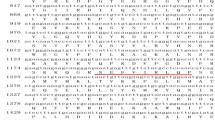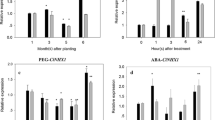Abstract
A cDNA, GLX1, encoding glyoxalase-I was isolated by differential screening of salt-induced genes in tomato. Glyoxalases-I and-II are ubiquitous enzymes whose functions are not clearly understood. They may serve to detoxify methylglyoxal produced from triosephosphates in all cells. The protein encoded by GLX1 shared 49.4% and 58.5% identity with glyoxalase-I isolated from bacteria and human, respectively. Furthermore, yeast cells expressing GLX1 showed a glyoxalase-I specific activity 20-fold higher than non-transformed cells. Both GLX1 mRNA and glyoxalase-I polypeptide levels increased 2- to 3-fold in roots, stems and leaves of plants treated with either NaCl, mannitol, or abscisic acid. Immunohistochemical localization indicated that glyoxalase-I was expressed in all cell types, with preferential accumulation in phloem sieve elements. This expression pattern was not appreciably altered by salt-stress. We suggest that the increased expression of glyoxalase-I may be linked to a higher demand for ATP generation and to enhanced glycolysis in salt-stressed plants.
Similar content being viewed by others
References
Allen RE, Lo TWC, Thornalley PJ: Inhibitors of glyoxalase I: design, synthesis, inhibitory characteristics and biological evaluation. Biochem Soc Trans 21: 535–540 (1993).
Bradford MM: A rapid and sensitive method for the quantitation of microgram quantities of protein utilizing the principle of protein-dye binding. Anal Biochem 72: 248–254 (1976).
Cesareni G, Murray JAH: Plasmids vectors carrying the replication origin of filamentous single-stranded phages. In: Setlow JK (ed) Genetic Engineering: Principles and Methods, vol. 9, pp. 135–159. Plenum Press, New York (1987).
Delcasso-Tremousaygue D, Grellet F, Panabieres F, Ananiev ED, Delseny M: Structural and transcriptional characterization of the external spacer of a ribosomal RNA nuclear gene from a higher plants. Eur J Biochem 172: 767–776 (1988).
Deswal R, Sopory SK: Purification and partial characterization of glyoxalase I from a higher plant Brassica juncea. FEBS Lett 282: 277–280 (1991).
Deswal R, Chakaravarty TN, Sopory SK: The glyoxalase system in higher plants: Regulation in growth and differentiation. Biochem Soc Trans 21: 527–530 (1993).
Devereux J, Haeberli P, Smithies O: A comprehensive set of sequence analysis programs for the VAX. Nucl Acids Res 12: 387–395 (1984).
Dudani AK, Srivastava LK, Prasad R: Glyoxalase-I activity and cell cycle regulation in yeast. Biochem Biophys Res Comm 119: 962–967 (1984).
Eschrich W, Heyser W: Biochemistry of Phloem Constitutents. In: Pierson A, Zimmermann MH (eds) Encyclopedia of Plant Physiology, vol. 1. Transport in Plants I: Phloem Transport, pp. 101–136. Springer-Verlag, Berlin (1975).
Godoy JA, Pardo JM, Pintor-Toro JA: A tomato cDNA inducible by salt stress and abscisic acid: nucleotide sequence and expression pattern. Plant Mol Biol 15: 695–705 (1990).
Hall TC, Ma Y, Buchbinder BU, Pyne JW, Sun SM, Bliss FA: Messenger RNA for G1 protein of french bean seeds: cell-free translation and product characterization. Proc Natl Acad Sci USA 75: 3196–3200 (1978).
Kimura A: Molecular breeding of yeast for production of useful compounds: Novel methods of transformation and new vector systems. In: Russell GE (ed), Yeast Biotechnology, pp. 39–57. Intercept (1988).
Lu T, Creighton DJ, Antoine M, Fenselau C, Lovett PS: The gene encoding glyoxalase I from Pseudomonas putida: cloning, overexpression, and sequence comparisons with human glyoxalase I. Gene 150: 93–96 (1994).
Lütcke HA, Chow KC, Mickel FS, Moss KA, Kern HF, Scheele GA: Selection of AUG initiation codons differs in plants and animals. EMBO J 6: 43–48 (1987).
Mannervik B, Ridderstrom M: Catalytic and molecular properties of glyoxalase I. Biochem Soc Trans 21: 515–517 (1993).
Mar H, Wight TN: Coloidal gold immunostaining on deplasticized ultra-thin sections. J Histochem Cytochem 36: 1387–1395 (1988).
Norton SJ, Talesa V, Yuan WS, Principato GB: Glyoxalase I and glyoxalase II from Aloe vera: purification, characterization and comparison with animal glyoxalases. Biochem Int 22: 411–418 (1990).
Norton SJ, Elia AC, Chyan MK, Gillis G, Frenzel C, Principato GB: Inhibitors and inhibition studies of mammalian glyoxalase II activity. Biochem Soc Trans 21: 545–549 (1993).
Paulus C, Kollner B, Jacobsen HJ: Physiological and biochemical characterization of glyoxalase I, a general marker for cell proliferation, from a soybean cell suspension. Planta 189: 561–566 (1993).
Ranganathan S, Walsh ES, Godwin AK, Tew KD: Cloning and characterization of human colon glyoxalase I. J Biol Chem 268: 5661–5667 (1993).
Rhee HI, Murata K, Kimura A: Molecular cloning of the Pseudomonas putida glyoxalase I gene in Escherichia coli. Biochem Biophys Res Comm 147: 831–838 (1987).
Richard JP: Mechanism for the formation of methylglyoxal from triosephosphates. Biochem Soc Trans 21: 549–553 (1993).
Rothstein R: Cloning in yeast. In: Glover DM (ed) DNA Cloning, vol. 2, pp. 45–66. IRL Press, Oxford (1985).
Sambrook J, Fritsch EF, Maniatis T: Molecular Cloning: A Laboratory Manual. Cold Spring Harbor Laboratory Press, Cold Spring Harbor, NY (1989).
Stanley KK, Luzio JP: Construction of a new family of high efficiency bacterial expression vectors: Identification of cDNAs clones coding for human liver proteins. EMBO J 3: 1429–1434 (1984).
Taylor B, Powell A: Isolation of plant DNA and RNA. Focus 4: 4–6 (1982).
Thornalley PJ: The glyoxalase system: new developments towards functional characterization of a metabolic pathway fundamental to biological life. Biochem J 269: 1–11 (1990).
Thornalley PJ: Modification of the glyoxalase system in disease processes and prospects for therapeutic strategies. Biochem Soc Trans 21: 531–534 (1993).
Umeda M, Hara C, Matsubayashi Y, Li H-H, Liu Q, Tadokoro F, Aotsuka S, Uchimiya H: Expressed sequence tags from cultured cells of rice (Oryza sativa L.) under stressed conditions: analysis of transcripts of genes engaged in ATP-generating pathways. Plant Mol Biol 25: 469–478 (1994).
Vallee BL, Auld DS: Active-site zinc ligands and activated H2O of zinc enzymes. Proc Natl Acad Sci USA 87: 220–224 (1990).
Velasco R, Salamini F, Barterls D: Dehydratation and ABA increase mRNA levels and enzyme activity of cytosolic GAPDH in the resurrection plant Craterostigma plantagineum. Plant Mol Biol 26: 541–546 (1994).
Author information
Authors and Affiliations
Rights and permissions
About this article
Cite this article
Espartero, J., Sánchez-Aguayo, I. & Pardo, J.M. Molecular characterization of glyoxalase-I from a higher plant; upregulation by stress. Plant Mol Biol 29, 1223–1233 (1995). https://doi.org/10.1007/BF00020464
Received:
Accepted:
Issue Date:
DOI: https://doi.org/10.1007/BF00020464




